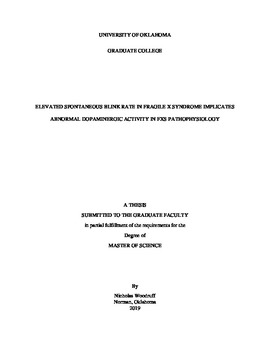| dc.description.abstract | Fragile X Syndrome (FXS) is the most common, single-gene cause of heritable Autism Spectrum Disorder (ASD) and intellectual disability (ID). FXS is characterized by sensory hypersensitivity, repetitive behaviors, anxiety, social deficits, and impaired executive function; behavioral impairments also found in ASD. Cortical hyperexcitability has been demonstrated in both FXS and ASD relative to controls, which correlates with the measures of symptom severity. This hyperexcitability results from impaired inhibitory GABA signaling as well as exaggerated excitatory glutamate signaling, and a great deal of research focused on the neurobiology of ASD and FXS is concerned with GABA and glutamate signaling. Despite the clear significance of GABA and glutamate signaling, there are also significant similarities between symptomology of FXS and disorders associated with dopamine (DA) signaling dysfunction such as Schizophrenia (SZ), Parkinson’s disease (PD), attention deficit hyperactivity disorder (ADHD), and obsessive-compulsive disorder (OCD). Furthermore, current pharmacological interventions for FXS commonly include drugs that effect DA signaling in some way, indicating a need to methodically evaluate the role of DA signaling in FXS.
Previous research has found that spontaneous eye blink rate (SBR) is elevated in adolescent males with FXS, and task-related changes in SBR correlated with symptom severity measures. SBR is a well-established proxy measure of DA signaling in animal models, which is also thought to be applicable in humans. In order to provide further evidence of a significant role of DA signaling in FXS pathophysiology it will be important to replicate and extend research focusing on a correlation between SBR and symptom measures in FXS to a much larger sample including a wider age range and both genders.
Towards this goal, data from 68 FXS subjects were evaluated to quantify blink rate, and correlations between blink rate dynamics, clinical assessment measures, and EEG data were evaluated in order to evaluate the hypothesis that DA signaling plays a major role in FXS-related behavioral impairments. Consistent with previous research, blink rate is significantly higher in FXS relative to typically developing controls. Significant correlations were found between blink rate and several clinical measures, but the strongest correlations were found between blink rate measures and clinical assessments of sensory processes. Somewhat surprisingly, these correlations show that higher blink rate within the FXS sample is associated with reduced sensory impairment, which suggests a compensatory role of DA signaling associated with sensory processing. Together, these data support the hypothesis that DA signaling is associated with some FXS behavioral impairments and suggest that elevated DA signaling may represent a compensatory response to cortical hyperexcitability. | en_US |
